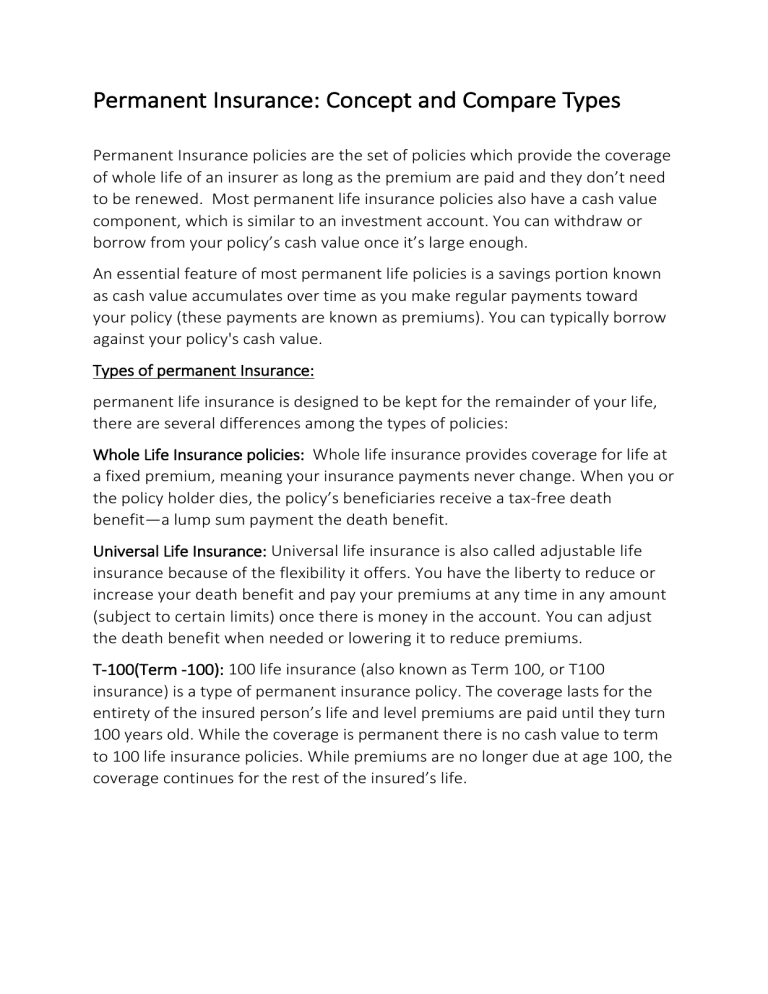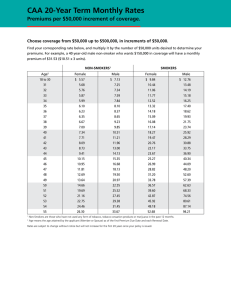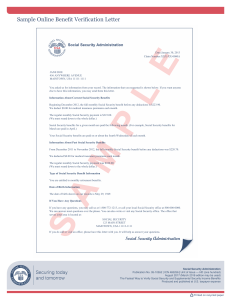
Permanent Insurance: Concept and Compare Types Permanent Insurance policies are the set of policies which provide the coverage of whole life of an insurer as long as the premium are paid and they don’t need to be renewed. Most permanent life insurance policies also have a cash value component, which is similar to an investment account. You can withdraw or borrow from your policy’s cash value once it’s large enough. An essential feature of most permanent life policies is a savings portion known as cash value accumulates over time as you make regular payments toward your policy (these payments are known as premiums). You can typically borrow against your policy's cash value. Types of permanent Insurance: permanent life insurance is designed to be kept for the remainder of your life, there are several differences among the types of policies: Whole Life Insurance policies: Whole life insurance provides coverage for life at a fixed premium, meaning your insurance payments never change. When you or the policy holder dies, the policy’s beneficiaries receive a tax-free death benefit—a lump sum payment the death benefit. Universal Life Insurance: Universal life insurance is also called adjustable life insurance because of the flexibility it offers. You have the liberty to reduce or increase your death benefit and pay your premiums at any time in any amount (subject to certain limits) once there is money in the account. You can adjust the death benefit when needed or lowering it to reduce premiums. T-100(Term -100): 100 life insurance (also known as Term 100, or T100 insurance) is a type of permanent insurance policy. The coverage lasts for the entirety of the insured person’s life and level premiums are paid until they turn 100 years old. While the coverage is permanent there is no cash value to term to 100 life insurance policies. While premiums are no longer due at age 100, the coverage continues for the rest of the insured’s life. T-100 Life Insurance 100 life insurance (also known as Term 100, or T100 insurance) is a type of permanent insurance policy. The coverage lasts for the entirety of the insured person’s life and level premiums are paid until they turn 100 years old. Term 100 minimize the impact of taxes on other taxable assets in your estate – such as the capital gains tax on the increase in value of your cottage and fulfil the need a source of funds to help your heirs: T100 premiums are cheaper than whole life plans and don’t fluctuate through the course of the plan, which means you can rest easy knowing the premiums you pay today will remain the same throughout the duration of your policy. Your premiums are fixed and remain level. No further premium required after age 100 Whole Life Insurance Meaning Whole life is an insurance that provides the insurance of whole life, means the insured person is covered for the duration of their life as long as premiums are paid on time Product Type Whole life insurance combines both an insurance and a saving component. While insurance protection offers a death benefit once the policyholder dies, the savings component accumulates value that can be used for different purposes. Coverage Insurance rates stay the same over the course of your life and they are significantly higher than the premiums one would pay for a comparable term insurance policy with the same coverage. Premium This policy is best to use when you have enough money to pay significantly higher premiums, in the beginning and you do not want to deal with investment choices, letting an insurer to invest for you Universal Life Insurance Universal life insurance is also called adjustable life insurance because of the flexibility it offers. You have the liberty to reduce or increase your death benefit and pay your premiums at any time in any amount (subject to certain limits) once there is money in the account. You can adjust the death benefit when needed or lowering it to reduce premiums. Universal life insurance unbundles the life insurance risk charge and the savings component. You can adjust your premium to pay for just the cost of insurance and policy fee or put in any extra money and accumulate cash value. There are a wide range of investment options from low risk to higher risk. You can, actually, vary how much you pay in premiums for your universal life insurance policy. It would impact your coverage and speed of accumulation. This policy is a good choice for people who value flexibility and flexible premiums. Fulfil the need of Life coverage, Can provide High coverage options. Requirement Type Maximize the Value of your assets. Effective way to replace the loss of income in case of death of policyholder. Minimize the Impact of taxes on your estate value, and maximize the wealth value.


